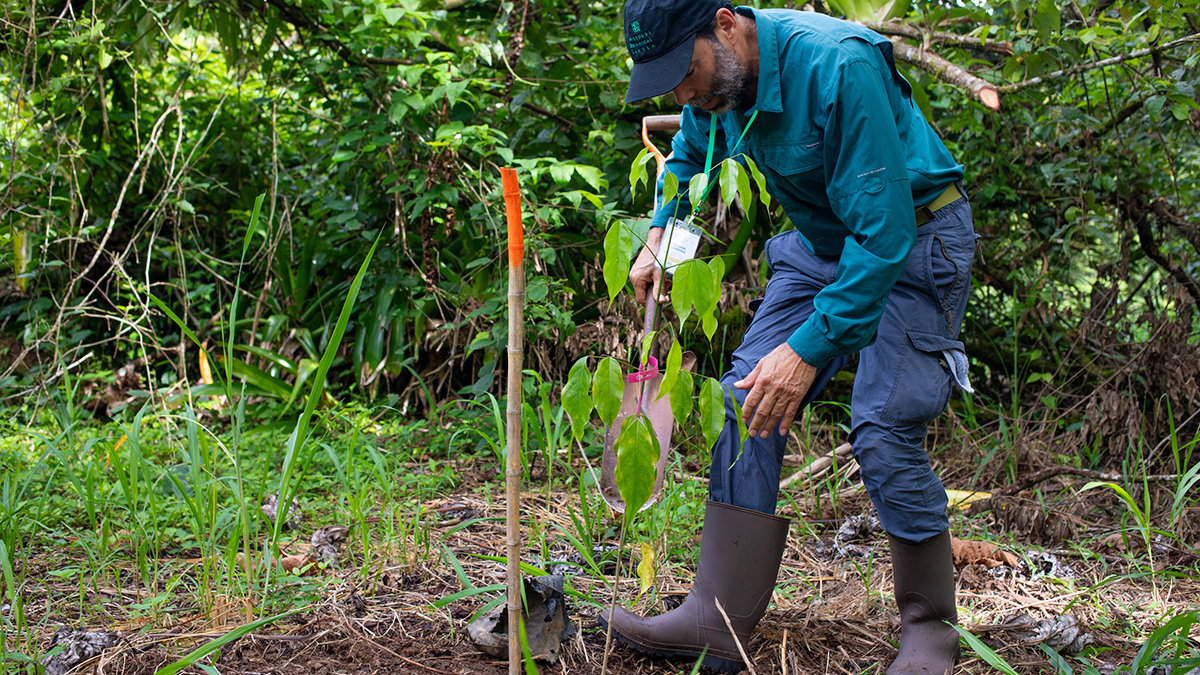A translation of this article was made possible by a partnership with Planeteando. Una traducción de este artículo fue posible gracias a una asociación con Planeteando.
Reforestation is more complicated than just planting trees. It includes evaluating habitats and ecosystems, identifying the health and sustainability of different species, and assessing strategies for establishing new stands of trees.
In regions like Mesoamerica, where forests are highly threatened by human activities and climate change, conservationists interested in reforestation need to prioritize species whose populations are shrinking. To help with this task, a group of researchers evaluated the conservation status of all 4,046 tree species endemic to Mesoamerica and described in the Global Tree Assessment project. They found that 46% of these trees are at some risk of extinction.
This study is the first to evaluate the status of all endemic trees in Mesoamerica.
The study, published in Plants, People, Planet, is the first to evaluate the status of all endemic trees in Mesoamerica.
Emily Beech, the study’s lead author and head of conservation at Botanic Gardens Conservation International, emphasized the importance of focusing on this region because of its high levels of biodiversity, which are frequently underrepresented. Central American countries (Belize, Costa Rica, El Salvador, Guatemala, Honduras, Nicaragua, and Panama), Beech said, are rarely listed as being among the most biodiverse or home to the highest number of endangered species. This absence is not due to a lack of biodiversity, she explained, but simply attributable to size. The countries’ small sizes cause them to be overshadowed by large countries with bigger forests, such as Brazil and the Democratic Republic of the Congo. But together with Mexico, Central America is home to 10% of the world’s plant diversity despite accounting for less than 1% of its land surface.
To address this gap, scientists first identified endemic Mesoamerican trees from assessments submitted to the International Union for Conservation of Nature (IUCN) Red List of threatened species. Then, to evaluate the trees’ conservation status, the researchers overlaid distribution maps of the selected tree species onto maps in the World Database on Protected Areas.
Of the 4,046 tree species analyzed, they found that 1,867 are under threat of extinction. Mexico was the only country to have tree species in the database that were extinct or extinct in the wild. Of extant trees, Mexico and Costa Rica had the highest numbers of threatened species, with 888 and 227, respectively. The most common threat overall was habitat loss due to agricultural expansion.
Most species (3,349) had at least one data point inside a protected area. Nevertheless, 72% of Mesoamerican species in protected areas are threatened.
A Tailored Approach
Neptalí Ramírez Marcial was not a part of the new research, but as head of the restoration group at South Border College in Mexico, he works with tree species that are under different threat categories. The forests of Chiapas, where he and his colleagues are based, used to be filled with oak trees, which supported high levels of biodiversity. Owing to human influence, pines now outnumber oaks, and the climate is less favorable to the sensitive species on the IUCN Red List.
Despite Ramírez Marcial’s use of the Red List, he remains critical of the tool and its use in research. For example, he pointed out that the new assessment of Mesoamerican trees lists Furcraea macdougallii (MacDougall’s century plant) as extinct in Mexico. Ramírez Marcial believes that this plant is similar to an agave and should not be considered a tree at all—and thus should not be included in the survey.
He also pointed out that the new study considers the entire country of Mexico to be part of Mesoamerica. From an ecological point of view, he said, the Mesoamerican biogeographic region extends only through central Mexico and excludes the northern part of the country, which has discrete ecosystems not shared with Central America.
Ocotea monteverdensis “went from not even being listed to being in the most vulnerable conservation category.”
Ramírez Marcial agreed with conclusions reached in the new study, however—that restoration strategies must consider the biodiversity of the areas they want to protect. For example, he pointed out that Mexican government programs prioritize distributing pines for reforestation efforts across the country instead of designing “tailored suits” for each region.
Daniela Quesada, a conservationist at the Monteverde Institute in Costa Rica, said the new study offers a more comprehensive view of the state of trees in Mesoamerica. However, like Ramírez Marcial, she considers information from the IUCN Red List to be a starting point for research. The accuracy of the Red List, she explained, depends on the amount of information submitted to it.
Quesada said the next step for tree conservation in Mesoamerica is for scientists to “take a closer look at each species that appeared” in the new study. A rigorous analysis of the presence and influence of each species in each region could influence the development of tailored conservation projects.
As an example, she mentioned the case of Ocotea monteverdensis, a tree that “went from not even being listed to being in the most vulnerable conservation category” (critically endangered) thanks to the work of ecologist John Devereux Joslin Jr. This recognition led to the development of a targeted, ongoing community conservation program for the tree.
—Roberto González (@perrobertogg.bsky.social), Science Writer

